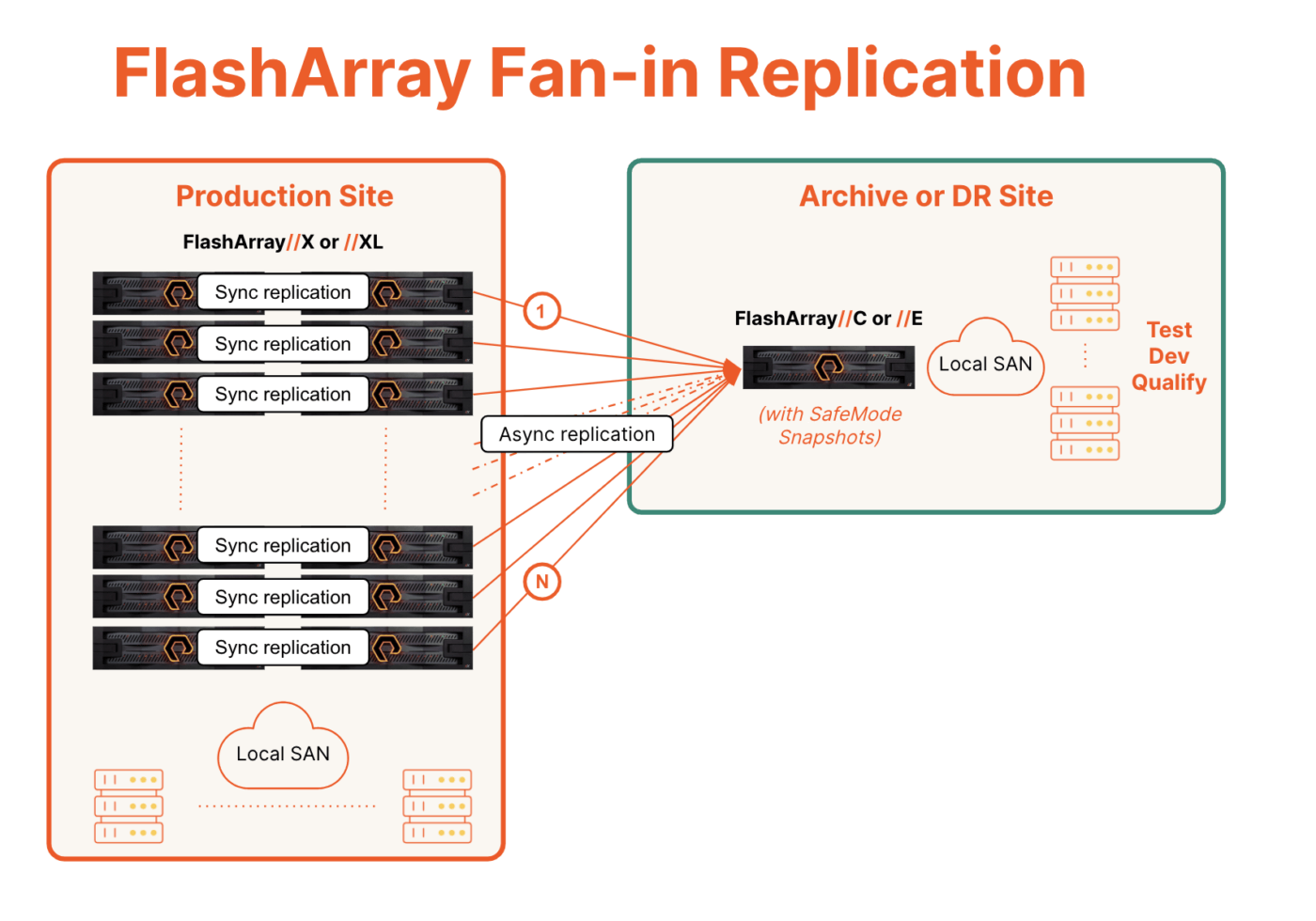Summary
Fan-in replication can help storage admins take control of data sprawl by consolidating their storage infrastructure and simplifying management.
Summary
Fan-in replication can help storage admins take control of data sprawl by consolidating their storage infrastructure and simplifying management.
As storage admins at heart, we know the struggle: Data keeps growing and applications multiply. Before you know it, your fleet has become a many-headed monster of disparate storage arrays, with siloed data and a complex web of backup jobs. Enter your knight in shining armor—snapshot consolidation via fan-in replication.
What Is Snapshot Consolidation?
Imagine a central fortress—a single, robust target storage array. The idea of snapshot consolidation is to replicate all the ransomware-resilient SafeMode™ Snapshots from your various source arrays, scattered across your data center, and converge it all into the target array. This consolidation simplifies management, enhances disaster recovery (DR), and offers a treasure trove of benefits.
Benefits for the Weary Storage Admin
- Conquer management headaches: Say goodbye to juggling multiple interfaces. Fan-in unifies backup tasks, replication jobs, and access control under one roof, streamlining your workflow.
- Vanquish backup nightmares: Tired of late nights managing backups from individual arrays? Fan-in centralizes everything, allowing for easy scheduling, monitoring, and verification from a single point.
- Disaster recovery woes, begone: Testing and maintaining DR plans for every array is a complex beast. Fan-in offers a single, centralized recovery point for all your critical data, simplifying disaster preparedness.
- Break down data silos and simplify reporting: Scattered data hinders analysis. Fan-in brings your data together, making it easier to run queries and generate reports across departments.
- Optimize your storage kingdom: Free up valuable space. Fan-in deduplicates data across source arrays before sending it to the target, maximizing your storage efficiency.
- Sleep soundly through hardware battles: Hardware failures are inevitable, but with fan-in replication and orchestrated failovers to the centralized target, your data is always protected, ensuring restful nights.

FlashArray//C™ and FlashArray//E™: The Economical Heroes of Snapshot Consolidation
FlashArray™ is well-suited for organizations with large data protection needs, high-capacity storage requirements, and a focus on energy efficiency and operational savings for your block workloads. Capacity-optimized FlashArray//C and FlashArray//E are perfect secondary storage superheroes for consolidating your snapshots using pgroup-based asynchronous replication.
FlashArray//C is designed to address operational workload requirements. It delivers consistent performance via its end-to-end all-NVMe architecture and density configurations that span up to 8.9PB effective—all in a compact form factor.
FlashArray//E delivers the benefits of flash storage—high performance, low latency—at a price point comparable to traditional disk arrays. This makes it an ideal choice for cost-sensitive environments where consolidation and efficiency are top priorities.
While fan-in represents a powerful sword, remember to consider these points:
- The target must be mighty: The central array needs the capacity and performance to handle the combined data load from all your sources.
- Planning is key: Carefully assess your needs and choose the right target array to avoid bottlenecks.
- Shield yourself from workload mismatches: Accurately sizing your workloads is critical for maximizing the benefits of fan-in replication with FlashArray//C or FlashArray//E. Consider both current and projected data volumes along with their data protection requirements, as well as the nature of your workloads, to select the appropriate size and configuration for your target array.
Fan-in Replication: A Strategic Choice
By consolidating your storage infrastructure and simplifying management, fan-in replication empowers you to focus on more strategic initiatives. So, take control of your data sprawl, and embrace the peace of mind that comes with a unified storage realm!

Written By:
Talk to Our Team
Set up a time to learn more about how Pure Storage can help make your life easier.






